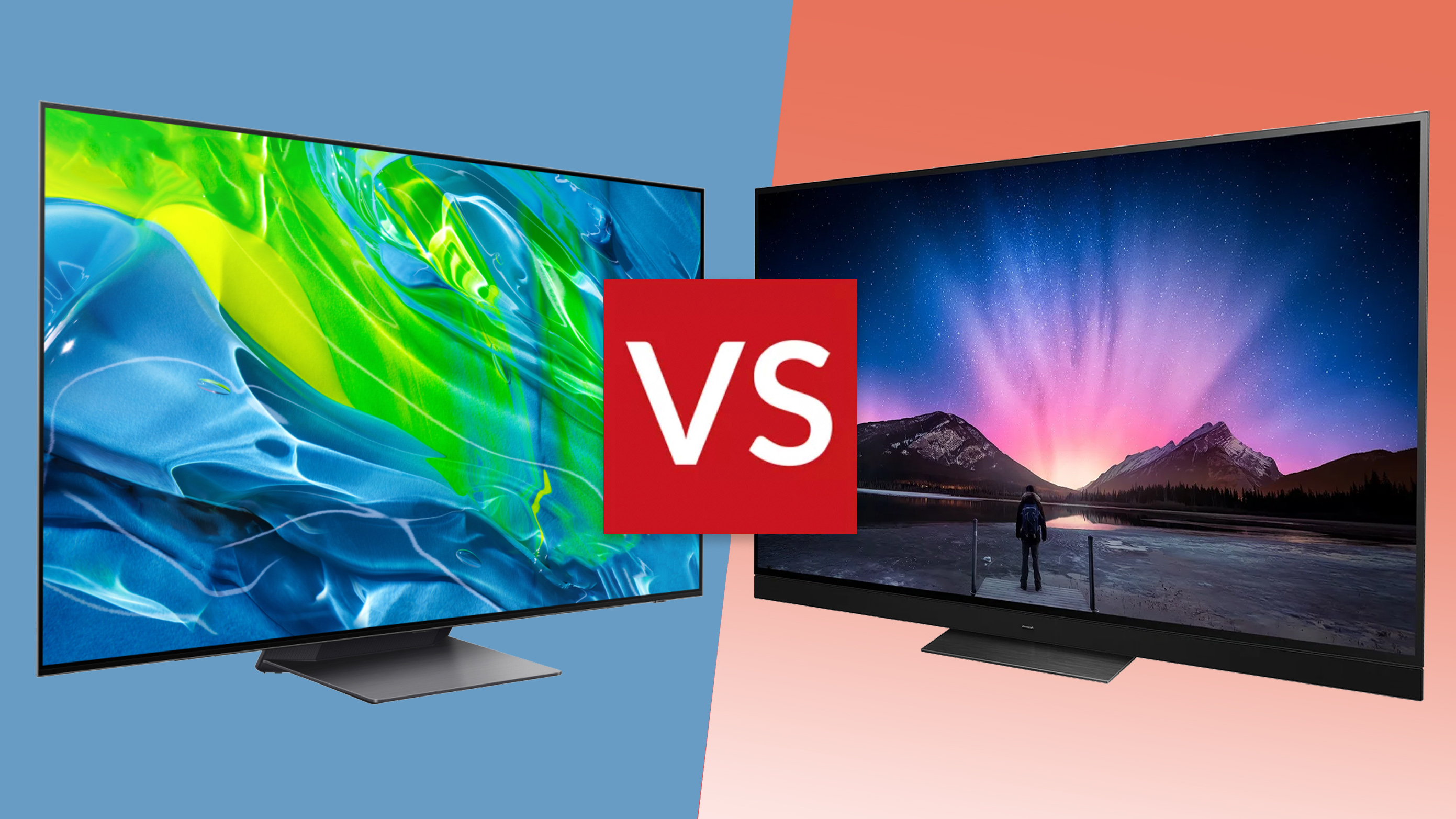
With its Hollywood-tuned Master OLED Pro panel and elaborate 360 Soundscape Pro Dolby Atmos sound system, the Panasonic LZ2000 is a home cinema dream screen. So can the Samsung S95B, with its Quantum Dot OLED panel and Object Tracking Sound (OTS), steal its thunder? Let’s compare!
The Panasonic LZ2000 and Samsung S95B look evenly matched when it comes to cutting-edge features. From their high brightness panels, boasting AI-powered sound and vision processing, to extensive support for next-gen gaming, a cursory glance indicates they tick roughly the same number of boxes.
The Samsung S95B is the new kid on the block, rewriting the rule book when it comes to OLED technology (if you want to know more about QD-OLED, here's our explainer). It can rival any bright-room LED TV, yet still manages to deliver cinema dynamics with inky blacks. The Samsung is no slouch when it comes to audio, either, boasting a 40W sound system with six speakers for multi-channel sound.
The Panasonic LZ2000 is similarly well appointed. It uses a Master OLED Pro panel (OLED EX as it's known) with proprietary heat management for higher brightness, coupled to the latest HCX AI pro processor. It also has a powerful 150W built-in Dolby Atmos sound system, complete with novel beam-steering across the front speaker array.
Panasonic LZ2000 vs Samsung S95B: Price
While both of these models are a ‘considered purchase’, the Samsung takes an early lead when it comes to value.
The 55-inch S95B sells for £1,599 / $1,699, while its 65-inch stablemate goes for £1,999 / $1,899.
The 55-inch Panasonic LZ2000 comes in at £1,999. The step-up 65-inch edition is £2,299. Panasonic doesn’t sell the LZ2000 in the US.
Get all the latest news, reviews, deals and buying guides on gorgeous tech, home and active products from the T3 experts
Samsung S95B vs Panasonic LZ2000: Design & Connectivity
The Panasonic and Samsung have very different design philosophies.
The LZ2000 looks premium and the quality of finish is high. It has a dark screen wraparound (it’s not really a bezel) and a central swivel stand. It’s not particularly slim, but then it is carrying sizeable height and width speakers on its back.
Connectivity is good, to a point. Only two of the four HDMI inputs support High Frame Rate (HFR) 4K 120Hz video, and one of these also handles eARC. That said, all have ALLM (Auto Low Latency Mode) and VRR support.
The S95B is a good deal thinner (Samsung calls the design LaserSlim). The panel has a chic silver bezel, and is parked on a central squared-off pedestal stand.
All four HDMI inputs are HDMI 2.1 compliant and support 4K 120fps playback. There’s VRR with Nvidia and AMD Freesync support, ALLM and eARC. When it comes to useful connectivity for gamers, the Samsung clearly has an edge.
Like the Panasonic, the Samsung incorporates multiple speakers to support Dolby Atmos, but they’re less conspicuous than those on the Panasonic.
The Panasonic LZ2000 ships with a single, hefty remote control. The Samsung actually comes with two zappers, a regular IR model and a slim, solar-powered alternative.
Panasonic LZ2000 vs Samsung S95B: Picture & sound
With different OLED panel technologies (as said: QD-OLED for the S95B, OLED EX for the LZ2000), and rival AI-powered processors, this performance showdown was always going to be fascinating.
The LZ2000 is very much an evolution of what we’ve seen from the brand’s previous Panasonic OLED flagships, and it doesn’t disappoint.
The screen uses a high-brightness OLED EX panel from LG Display, boosted by a proprietary heatsink with custom modifications inside the cell itself. The heatsink sucks heat away from the panel, allowing overall brightness to be increased.
We measured peak HDR brightness at around 1000 nits, using the Normal image default. The LZ2000 boasts multi-HDR support, including Dolby Vision IQ and HDR10+ Adaptive, both of which dynamically analyse ambient room lighting to manage picture characteristics.
The Samsung S95B uses an all-new QD-OLED panel, which employs a Quantum Dot layer to derive hues from a single blue OLED source. This allows it to offer a brighter overall picture. We measured HDR peak brightness at 1400 nits. HDR support covers HLG, HDR10 and HDR10+ , but there’s no Dolby Vision.
Imagery is managed by a Neural Quantum Processor 4K with Intelligent AI-optimised AV mode. Likewise, the Panasonic uses its HCX Pro AI processor, but takes a more filmic approach.
If you’re a movie fan, then you’re going to like the fact that the LZ2000 looks more cinematic. The provision of Dolby Vision is a clear plus. But when it comes to bright-room viewing, the extra luminosity of the S95B wins out.
Sonically, Panasonic’s bulkier Dolby Atmos sound system has greater dynamics and offers more profound immersion. The Samsung gives it a run for its money, but doesn’t offer quite as deep or wide a soundstage.
S95B vs LZ2000: So which wins?
Both the Panasonic LZ2000 and Samsung S95B are lust-worthy, head-turning OLED screens. So which one wins?
If you’re a home cinema fan, then the Panasonic would be our recommended buy. Its images are gorgeously cinematic, Dolby Vision IQ is a must, and the onboard sound system creates a genuinely immersive soundscape.
But if you’re more concerned with gaming and style, then the Samsung S95B comes out on top, thanks to more connectivity options and sharp, lifestyle design. It's a little cheaper too, given that its soundsystem isn't quite as qualified.
For over 25 years, Steve has been casting his keen eyes and ears over the best that the world of TV and audio has to offer. He was the creator of Home Cinema Choice magazine, and contributes to huge range of technology, home and music titles along with T3, including TechRadar, Louder, Ideal Home, the i newspaper, and more.

